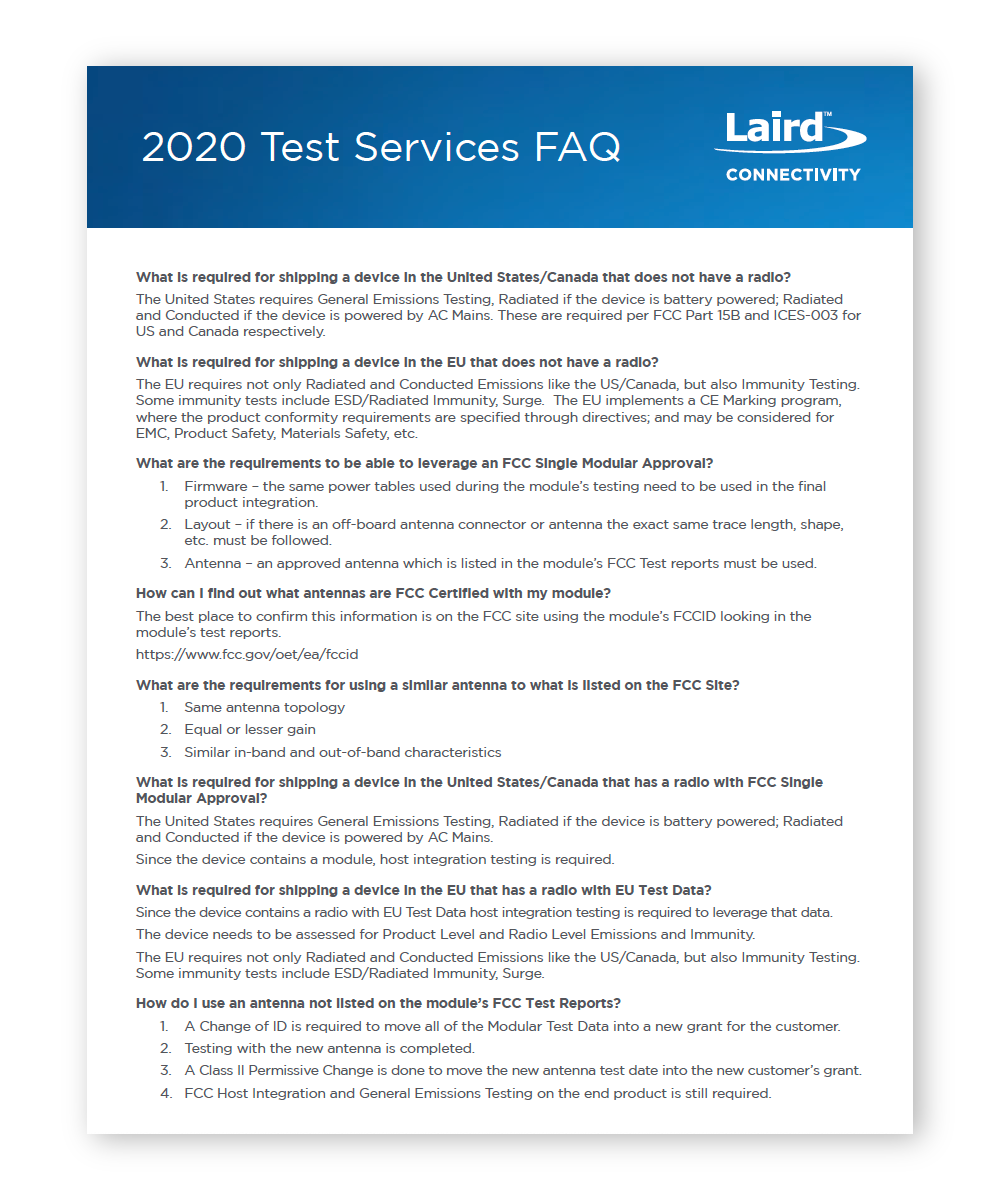
EMC Test Services FAQ
Published on December 8, 2020

What is required for shipping a device in the United States/Canada that does not have a radio?
The United States requires General Emissions Testing, Radiated if the device is battery powered; Radiated and Conducted if the device is powered by AC Mains. These are required per FCC Part 15B and ICES-003 for US and Canada respectively.
What is required for shipping a device in the EU that does not have a radio?
The EU requires not only Radiated and Conducted Emissions like the US/Canada, but also Immunity Testing. Some immunity tests include ESD/Radiated Immunity, Surge. The EU implements a CE Marking program, where the product conformity requirements are specified through directives; and may be considered for EMC, Product Safety, Materials Safety, etc.
What are the requirements to be able to leverage an FCC Single Modular Approval?
- Firmware – the same power tables used during the module’s testing need to be used in the final product integration.
- Layout – if there is an off-board antenna connector or antenna the exact same trace length, shape, etc. must be followed.
- Antenna – an approved antenna which is listed in the module’s FCC Test reports must be used.
How can I find out what antennas are FCC Certified with my module?
The best place to confirm this information is on the FCC site using the module’s FCCID looking in the module’s test reports.
https://www.fcc.gov/oet/ea/fccid
What are the requirements for using a similar antenna to what is listed on the FCC Site?
- Same antenna topology
- Equal or lesser gain
- Similar in-band and out-of-band characteristics
What is required for shipping a device in the United States/Canada that has a radio with FCC Single Modular Approval?
The United States requires General Emissions Testing, Radiated if the device is battery powered; Radiated and Conducted if the device is powered by AC Mains.
Since the device contains a module, host integration testing is required.
What is required for shipping a device in the EU that has a radio with EU Test Data?
Since the device contains a radio with EU Test Data host integration testing is required to leverage that data.
The device needs to be assessed for Product Level and Radio Level Emissions and Immunity.
The EU requires not only Radiated and Conducted Emissions like the US/Canada, but also Immunity Testing. Some immunity tests include ESD/Radiated Immunity, Surge.
How do I use an antenna not listed on the module’s FCC Test Reports?
- A Change of ID is required to move all of the Modular Test Data into a new grant for the customer.
- Testing with the new antenna is completed.
- A Class II Permissive Change is done to move the new antenna test date into the new customer’s grant.
- FCC Host Integration and General Emissions Testing on the end product is still required.
How do I use an antenna not listed on the module’s EU Test Reports?
- Testing with the new antenna is required.
- The EU is Self-Declaration so the new Antenna Test Report is kept on hand and not filed with a governing body.
- Host Integration Testing, Product Level EMC, and Radio Level EMC need to be assessed.
How do I have to go about labeling my product when I use a wireless module?
- The end product must have the following: “Contains Transmitter Module FCC ID: XYZMODEL1” or “Contains FCC ID”.
- The user manual must call out the specific language in the module’s data sheet.
How does it affect my certification testing if I have multiple radios inside my device?
When a device contains multiple radios that can transmit at the same time the device must be assessed for Simultaneous Transmission for the FCC.
No specific requirement is outlined for simultaneous transmission for EU, but the device must be evaluated to ensure that when both radios are operating at the same time, it is still in conformance with the manufacturer’s Declaration of Conformity.
How do I know if SAR Testing is required for my device?
The RF Exposure Report has calculations that will provide insight as to whether the module is SAR exempt. Based on this information, and the separation distance of the antenna to the human body, duty cycle, use case, etc., it can be determined if SAR is applicable.
When using a single modular certified radio, it is important to understand that SAR Testing is host dependent; and while it may be exempted based on the RF Exposure, there may need to be a permissive change to update the grant of authorization if the separation is less than 20cm.
I want to develop my own module, what is required:
The FCC has 8 Points of Modular Certification:
- RF circuitry must be shielded
- Buffered modulation/data inputs. Module must inherently ensure compliance under host fault (watch dog) conditions
- Power supply regulation on the module.
- Permanently attached antenna or unique antenna connector.
- The module must demonstrate compliance in a stand alone configuration
- The module must be labeled with its permanently affixed FCC ID label or use an electronic display
- User manual needs to provide comprehensive instructions to explain compliance requirements.
- Module must comply with RF exposure requirements
 Laird Connectivity is now Ezurio
Laird Connectivity is now Ezurio